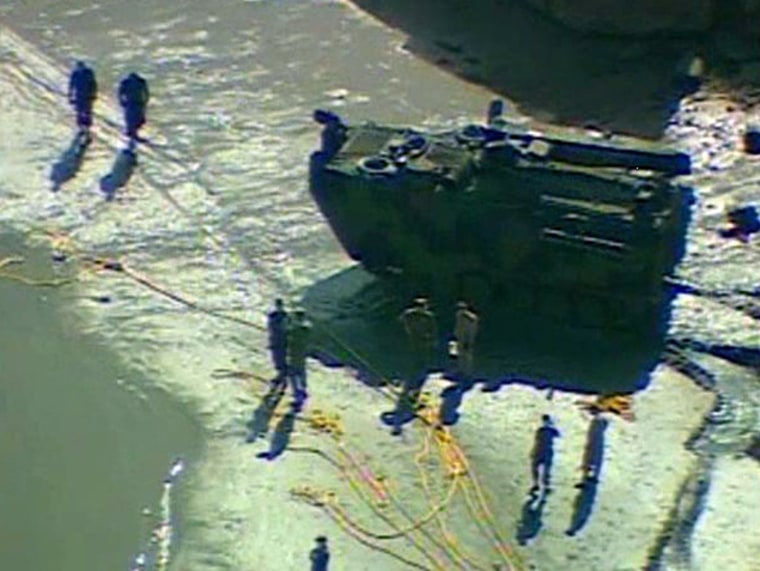A Marine trapped inside a sunken amphibious assault vehicle for two hours at the bottom of Oceanside Harbor was declared dead Friday afternoon, NBC station KNSD reported.
Five others were rescued after the 11:30 a.m. (2:30 p.m. ET) sinking.
According to a spokesperson with the 15th Marine Expeditionary Unit, search and rescue crews had pumped oxygen into the vehicle to increase the chances of the Marine's survival.
“Unfortunately, we were unable to recover the Marine in time,” said Maj. Daniel J. Thomas.
“To the family, our condolences go to them, on behalf of the Assault Amphibian Battalion and obviously all the Marines here at Camp Pendleton,” Thomas said.
The Marine, who was not identified, was recovered around 2:15 p.m. (5:15 p.m. ET) and transported by Mercy Air to Scripps La Jolla. He was pronounced dead at 2:47 p.m.
Three instructors and three students were conducting driver training at the Del Mar Boat Basin at Camp Pendleton when the vehicle sank about 300 feet offshore in water about 30 to 40 feet deep, officials said.
Five were able to get out of the vehicle. Three of them were sent to hospitals but none of the five were injured, officials said.
Officials did not say if the fatality was an instructor or a student.
The training vehicle, which moves Marines between ships and shore, was part of the Amphibious Assault Vehicle Schools Battalion, KNSD said.
Thomas described the vehicle as 32 to 36 tons, introduced in 1972, and made to travel on land and under water. Besides a driver and instructor, they can carry an additional 20 Marines.
“For them this is their initial driver training in the water at the basin controlled environment before they go into the open ocean,” Thomas said of Marine training.
“The vehicle is never operated alone. We always have two vehicles that go out so it can have a chase vehicle with it. So we had two vehicles in the water so that if something does occur, another vehicle can respond. Those procedures were in place and being followed,” Thomas said.
Marines were not placing a hold on training, he said.
“But obviously we’re going to take a look at this and the commander will then make a decision before anything goes back into place to make sure any safety briefing that need to be given are conducted,” Thomas said. “There will be a thorough investigation into this mishap that occurred and based off that, we will have… reports that come, lessons learned in terms of preventing anything like this from happening,” he said.
The vehicle called an Amtrac or hog is a seafaring tank armed with a .50-caliber machine gun and a grenade launcher, the San Diego Union-Tribune said. After leaving a ship, the vehicles often drop below the surface before they pop above water. They travel about 8 miles per hour on water and 45 miles per hour on land with as many as 24 fully loaded combat Marines into battle.
The vehicles are not the same as the Expeditionary Fighting Vehicle, which the Marine Corps tested at Del Mar basin, the North County Times said. Last week, Defense Secretary Robert Gates canceled EFV development in a Pentagon cost-cutting move.
